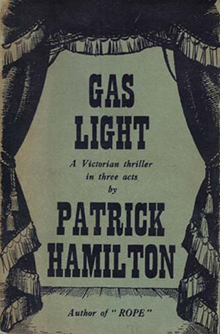| Gas Light A Victorian Thriller in Three Acts | |
|---|---|
 First edition 1939 | |
| Written by | Patrick Hamilton |
| Characters |
|
| Date premiered | 5 December 1938 |
| Place premiered | Richmond Theatre, Richmond, London |
| Original language | English |
| Genre | Thriller |
| Setting | On Angel Street, in the Pimlico district of London, 1880 |
Gas Light is a 1938 thriller play, set in 1880s London, written by the British novelist and playwright Patrick Hamilton.[1] Hamilton's play is a dark tale of a marriage based on deceit and trickery, and a husband committed to driving his wife insane in order to steal from her.[1]
Gas Light was written during a dark period in Hamilton's life.[1] Six years prior to the play Hamilton was hit by a drunk driver and dragged through the streets of London, leaving him with a limp, a paralysed arm, and a disfigured face.[2][3] Two years later, Hamilton's mother took her own life.[2]
Premiering at the Richmond Theatre in London on 5 December 1938 before transferring to the Apollo Theatre in the West End on 1 January, the play closed after six months and 141 performances,[4] but it has endured through an impressive list of incarnations[1] most notably Five Chelsea Lane (1941 American play – renamed for Los Angeles production), Angel Street (1941 American play – renamed again when Los Angeles production transferred to Broadway), and Gaslight (1958 Australian television play). Angel Street was a hit in its Broadway premiere, and it remains one of the longest-running non-musicals in Broadway history, with 1,295 total performances.[5][6]
The play was adapted to the big screen as two films, both entitled Gaslight—a 1940 British film, and a 1944 American film directed by George Cukor, also known as The Murder in Thornton Square in the UK. Both films are considered classics in their respective countries of origin, and are generally equally critically acclaimed. The 1944 American version received seven nominations at the 17th Academy Awards, including Best Picture, and won two, Best Actress (for Ingrid Bergman) and Best Production Design. In 2019, the film was selected for preservation in the United States National Film Registry by the Library of Congress as being "culturally, historically, or aesthetically significant".[7][8][9]
- ^ a b c d Bellafante, Ginia (24 May 2007). "Crazy, He Calls Me (and Terrified, I Agree)". The New York Times. Archived from the original on 5 June 2015. Retrieved 24 May 2007.
- ^ a b Frezza, Daniel. "About the Playwright: Gaslight". Southern Utah University. Archived from the original on 12 January 2021.
- ^ "An Inventory of His Collection at the Harry Ransom Humanities Research Cente". The University of Texas at Austin, University of Texas Libraries. Archived from the original on 12 January 2021. Retrieved 1 September 2021.
- ^ Wearing, J. P. (2014). The London Stage 1930–1939: A Calendar of Productions, Performers, and Personnel. Lanham, Maryland: Rowman & Littlefield. p. 740. ISBN 9780810893047.
- ^ "Angel Street". IBDB.com. Internet Broadway Database.
- ^ [1][permanent dead link] philadelphiaweekly.com
- ^ Tartaglione, Nancy (11 December 2019). "National Film Registry Adds 'Purple Rain', 'Clerks', 'Gaslight' & More; 'Boys Don't Cry' One Of Record 7 Pics From Female Helmers". Deadline Hollywood. Retrieved 11 December 2019.
- ^ "Complete National Film Registry Listing". Library of Congress, Washington, D.C. Retrieved 2 October 2020.
- ^ "Women Rule 2019 National Film Registry". Library of Congress, Washington, D.C. Retrieved 2 October 2020.